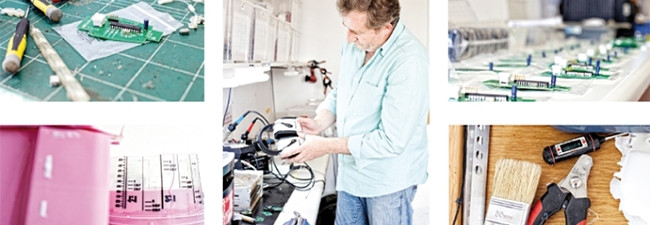
A shabby building in Johannesburg does nothing to advertise the ingenuity taking place behind its entrance.
In what looks like a cross between a computer lab and a toyshop, Dr Dirk Koekemoer has developed a portable device to test for deafness and predict which patients are likely to lose their hearing so they can be treated in good time. Since the loss of hearing is the most common chronic disability in the world, his KUDUwave could soon become a global trailblazer.
Koekemoer is a former general practitioner who quit to create eMoyo, a technology company designing machines to analyse patients more efficiently than a human can. He's achieved it too, but the biggest hurdle is to convince other doctors that machinery can beat man.
At one time, he had 16 devices in various stages of development, from drawings on paper to completed prototypes. Then he realised he had to focus on one product, and chose the KUDUwave audiometer because deafness is so rife and so debilitating. "It's a massive problem," Koekemoer says. "One out of 20 people on the planet is hearing disabled, and 750 million people worldwide have a hearing disability."
The KUDUwave costs R50 000 and consist of headphones and a software analysis program. He demonstrates how it works, putting transmitters into my ears, then placing a large headset over my ears. I press a button each time I hear a peep, and the results show up on a computer screen full of graphs.
Dots appear on the graphs as I press the button, showing which sound frequencies I can hear. It's quick, painless, intriguing and, for me, reassuring - I have normal hearing. If he would have picked up a problem, he would advise on the necessary treatment, because different types of hearing problems need different solutions.
One important use is for multi-drug resistant TB, because an antibiotic used to treat this highly resistant disease has the disastrous side effect of causing deafness.
The KUDUwave shows when a patient is at risk of deafness by flagging the loss of hearing in very high frequency ranges. Once that deterioration begins, full-blown deafness is on the way. A doctor alerted to the risk can switch that patient to a more expensive, but safer antibiotic.
Pre-emptive cure
At the moment that pre-emptive cure rarely happens because hospitals only have fixed sound booths for hearing tests, and a bedridden TB patient on an oxygen mask can't be shoved into a sound booth.
These portable tests are a breakthrough and Koekemoer hopes to see KUDOwaves installed in clinics and occupational therapy centres across the country. He also wants to train audiologists to travel to schools across the country to conduct deafness tests on pupils, to factories to check for noise-induced hearing loss, and to old age homes and pharmacies.
About 500 machines have been sold so far, mostly to occupational therapy centres. The Department of Health has bought 150 for its primary healthcare clinics, and could buy many more, since it operates about 4 500 clinics.
"It could become massive," Koekemoer says. "With our current potential orders, we are looking at selling 2 100 before the end of the year, and that's conservative. Maybe we'll only sell ten a month, but right now, it's doubling every month. We're focusing on getting the KUDUwave into doctors' offices and running screening programmes in various schools."
One device has been donated to Witkoppen Primary Healthcare Clinic, which is now testing up to 70 patients a day.
Test results are fed back to eMoyo over the internet, and Koekemoer uses the sophisticated software to interpret the results and send a report back to the doctor. Eventually, he aims to give the device away for free and make money by providing the analysis. That remote analysis ability allows the device to be used in rural clinics and the results sent to trained audiologists anywhere in the world for interpretation.
Because the KUDUwave is a new invention, its components are unique, so eMoyo produces them itself using a 3D printer. Other plastic parts are moulded from resin poured into little pink moulds.
Although the business has only just broken even and being a doctor was far more lucrative, Koekemoer is doing what he always wanted to do. "At school, I wanted to be a biomedical engineer and help people who can't hear hear again and people who can't see see again," he says. "I wanted to get into technologies that can change lives."
He studied medicine and went into private practice as a doctor, then began developing his own software. One day, he literally stood up in his consulting rooms and told his receptionist to cancel all appointments and tell his patients he'd quit to launch a software company.
For the KUDUwave, he wrote the core software, developed the user interface and designed the electronics, then hired electrical engineers and more software developers to fine-tune the product. After multiple clinical trials, the final version went into production. Now the staff has risen from eight to 22 to cope with the growing sales and develop further enhancements. "We have about ten engineers here designing future technologies for it and designing other ideas," he says.
This article was first published in Brainstorm magazine. Click here to read the complete article at the Brainstorm website.
Share